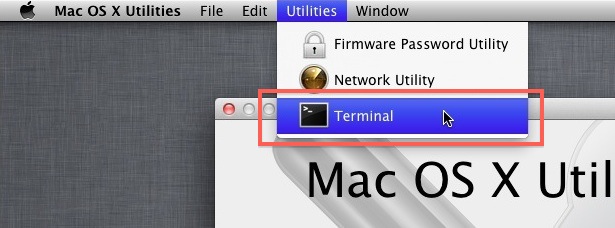Launch and Use Any Mac OS X App When Booted from OS X Lion Recovery HD Drive

Whether you made a Lion recovery drive with Apple’s Lion Recovery Disk Assistant Tool and you’re booting from that or you’re just relying on the Recovery HD partition, this technique works.
1) Boot from a Recovery Disk and Launch Terminal
First things first, regardless of which boot device you use, you have to open the Terminal.
- Boot from Recovery HD or the external Recovery Drive by holding Option at startup and selecting the disk, boot is completed when you see the “Mac OS X Utilities” window
- Click on the “Utilities” menu and pull down to “Terminal”
You’ll be confronted with the command line, which is where you can launch other apps. Now is also where it matters whether you’re booting from the internal Recovery HD partition, or an external Lion recovery drive you made with Apple’s assistant tool.
2) Launch Apps from Macintosh HD While Booted from an External Recovery Disk
As long as the built-in drive is still functioning and Macintosh HD is mounted, you can still access your full app library while booted from an external recovery disk. All you need to do is use the proper full path to the mounted volume, the default is Macintosh HD but you can find what it is with this command:
ls /Volumes/
We’ll continue to assume “Macintosh HD” is your hard disk name for this walkthrough. Now here’s the interesting part, typically you can launch applications from the Terminal with the ‘open’ command, but the Lion Recovery drives have a stripped down set of commands available to them, so that doesn’t work. What to do? Point to full path of the app itself, inside the .app container. I found that important little tidbit on MacFixIt (screenshot source too), so the format we’ll want to use for launching apps from the external boot disk is:
/Volumes/Macintosh\ HD/Applications/APPNAME.app/Contents/MacOS/APPNAME
For example, we can launch Network Utility with:
/Volumes/Macintosh\ HD/Applications/Utilities/Network\ Utility.app/Contents/MacOS/Network\ Utility
Be sure to escape any spaces in the path with the backslash \ for proper execution. You can also set apps to run in the background so that you can continue to use the Terminal by ending the command string with an ampersand:
/Volumes/Macintosh\ HD/Applications/Twitter.app/Contents/MacOS/Twitter &
Using this method you can actually run concurrent instances of apps without using the traditional ‘open -n’ command method.
3) Launch Apps While Booted from Internal Recovery HD Partition
If you are booting from the internal Recovery HD partition rather than an external recovery drive, the command syntax is shorter and thus slightly easier, because you don’t have to specify which volume to launch the app from.
This time to launch Twitter, it would be:
/Applications/Utilities/Twitter.app/Contents/MacOS/Twitter &
And Network Utility would be:
/Applications/Utilities/Network\ Utility.app/Contents/MacOS/Network\ Utility
Because you don’t have to specify a volume, you can peck around in your /Applications/ directory, just be sure to point the path beyond the .app and into the contents, following this general syntax:
/Applications/AppName.app/Contents/MacOS/AppName
Some apps are minimally useful in a situation like this, but others are undoubtedly useful. For example, launching Keychain Access could be an easy way to recover app or website specific passwords, although you’d still need the administrator password to unlock the keychain.
However you find a use, this is a great troubleshooting technique because it allows you to branch out from the limited selection of apps available to you when booted from Recovery HD or an OS X Lion install drive.


Hi,
Same issue here : it DOES NOT WORK !!!
Never mind about twitter or running the bin in the bg or open-ing it … it FAILS :
illegal instruction : 4
is the error message and you get back to the prompt !
So HOW do you run 3rd party while booted in (internal)Recovery ???
Thanks.
What version of MacOS are you using?
Follow the instructions as written, use the ‘open’ command. You might want to use ‘sudo open /path/to/application’ to launch the program.
Erm,
Sorry I missed the part where you mentioned that doesn’t work. Now I look like a buffoon.
That loads the binary inside the app bundle. I think the real OSX way is to do something like ‘open /Applications/AppName.app’
[…] trick, originally posted over at OS X Daily, will work whether you are booting from a USB restore drive made using Apple’s new tool, or […]
Why do you keep Twitter.app in your Utilities folder?
Oops just a typo, thanks for catching that